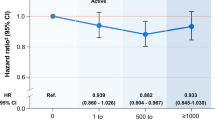Abstract
Left ventricular hypertrophy (LVH) is a dominant characteristic of cardiovascular mortality. We investigated the interaction between physical activity and LVH on stroke mortality, based on a 40-year follow-up of the Corfu cohort from the Seven Countries Study. The population studied consisted of 529 rural men (40–59 years old) enrolled in the Study at 1961. LVH was electrographically confirmed according to Minnesota coding. Physical activity levels were assessed by self-reports of habitual, occupational and leisure-time activities. Cox proportional hazard models were used to evaluate exercise levels with respect to stroke mortality in people with and without LVH. During the follow-up, 461 (87%) died, and 74 (16%) of these deaths were due to stroke. LVH was present in 40 (7.5%) men. A total of 362 (68%) men were defined as physically active. Physical activity was associated with a lower risk of stroke (hazard ratio=0.65, P<0.05). On the other hand, LVH had 5.8-fold the risk of stroke (P<0.001) among sedentary and 4.5-fold the risk (P<0.001) among physically active men, after controlling for several potential confounders. However, moderate physical activity decreased the risk of stroke by 49% in men with LVH as compared to sedentary without LVH (hazard ratio=0.51, P<0.01), while hard exercise did not confer any significant reduction in stroke risk. We revealed the benefits from moderate physical activity on stroke mortality among men with LVH. Physicians and other health-care professionals should encourage patients with LVH to adopt a physically active lifestyle.
This is a preview of subscription content, access via your institution
Access options
Subscribe to this journal
Receive 12 digital issues and online access to articles
$119.00 per year
only $9.92 per issue
Buy this article
- Purchase on Springer Link
- Instant access to full article PDF
Prices may be subject to local taxes which are calculated during checkout

Similar content being viewed by others
References
Warlow CP . Epidemiology of stroke. Lancet 1998; 352: 14.
Kiely DK et al. Physical activity and stroke risk: the Framingham Study. Am J Epidemiol 1994; 139: 881–893.
Levy D et al. Prognostic implications of echocardiographically determined left ventricular mass in the Framingham Heart Study. N Engl J Med 1990; 322: 1561–1564.
Benjamin EJ, Levy D . Why is left ventricular hypertrophy so predictive of morbidity and mortality? Am J Med Sci 1999; 317: 168–175.
Rodriguez C et al. Physical activity attenuates the effect of increased left ventricular mass on the risk of ischemic stroke. J Am Coll Cardiol 2002; 39: 1482–1488.
Kokkinos P et al. Effects of exercise on blood pressure and left ventricular hypertrophy in African-Americans with severe hypertension. N Engl J Med 1995; 333: 1462–1467.
Keys A et al. Epidemiological studies related to coronary heart disease: characteristics of men aged 40–59 in seven countries. Acta Med Scand 1967; 460: 350–354.
Furberg CD et al. Major electrocardiographic abnormalities in persons aged 65 years and older. Cardiovascular Health Study Collaborative Research Group. Am J Cardiol 1992; 69: 1329–1335.
Anderson JT, Keys A . Serum cholesterol in serum and lipoprotein fractions: its measurement and stability. Clin Chem 1956; 2: 145–159.
Menotti A, Seccareccia F . Risk factors and mortality patterns in the Seven Countries Study. In: Toshima H, Koga Y, Blackburn H (eds) Lessons for Science from the Seven Countries Study. Springer: Tokyo. 1994, pp 17–34.
Menotti A et al. Twenty-year mortality and prediction of stroke in twelve cohorts of the Seven Countries Study. Int J Epidemiol 1990; 19: 309–315.
Panagiotakos DB et al. Forty-year (1961–2001) of all cause mortality and its determinants: the Corfu cohort from the Seven Countries Study. Int J Cardiol 2003; 90: 73–79.
Summary of the Surgeon General's report addressing physical activity and health. Nutr Rev 1996; 54: 280–284.
Lee IM, Paffenbarger Jr RS . Physical activity and stroke incidence: the Harvard Alumni Health Study. Stroke 1998; 29: 2049–2054.
Thrainsdottir IS et al. Survival and trends of occurrence of LVH, gender differences, 1967–1992; the Reykjavik study. J Intern Med 2003; 253: 418–424.
Martnez MA et al. Prevalence of left ventricular hypertrophy in patients with mild hypertension in primary care; impact of echocardiography on cardiovascular stratification. Am J Hypertens 2003; 16: 556–563.
Bikkina M et al. Left ventricular mass and risk of stroke in elderly cohort. JAMA 1994; 272: 33–36.
Fletcher GF et al. Benefits and recommendations for physical activity programs for all Americans. A statement for health professionals by the Committee on Exercise and Cardiac Rehabilitation of the Council on Clinical Cardiology, American Heart Association. Circulation 1992; 86: 340–344.
Fletcher GF et al. Statement on exercise: benefits and recommendations for physical activity programs for all Americans. Circulation 1996; 94: 857–862.
Folkins CH, Sime WE . Physical activity training and mental health. Am J Psychol 1981; 36: 373–389.
Acknowledgements
We are grateful to Dr Dia Pitsavos, Mrs Klio Dontas and Dr Anastasia Katinioti for their substantial assistance during the 40 years follow-up. We are grateful particularly to the men of the villages of Corfu whose cooperation made this follow-up study feasible. Also, we thank the mayors of the villages, the register of the city of Corfu, the director and the staff of the San Marcos Medical Center as well as the microbiological laboratory of the Corfu's Prefectorial Hospital for their substantial support at the follow-up.
The Seven Countries Study was funded by Grants HE 04697, HE 6090 and HE00278 from the National Heart, Lung and Blood Institute.
Author information
Authors and Affiliations
Corresponding author
Rights and permissions
About this article
Cite this article
Pitsavos, C., Panagiotakos, D., Chrysohoou, C. et al. Physical activity decreases the risk of stroke in middle-age men with left ventricular hypertrophy: 40-year follow-up (1961–2001) of the Seven Countries Study (the Corfu cohort). J Hum Hypertens 18, 495–501 (2004). https://doi.org/10.1038/sj.jhh.1001692
Received:
Revised:
Accepted:
Published:
Issue Date:
DOI: https://doi.org/10.1038/sj.jhh.1001692



